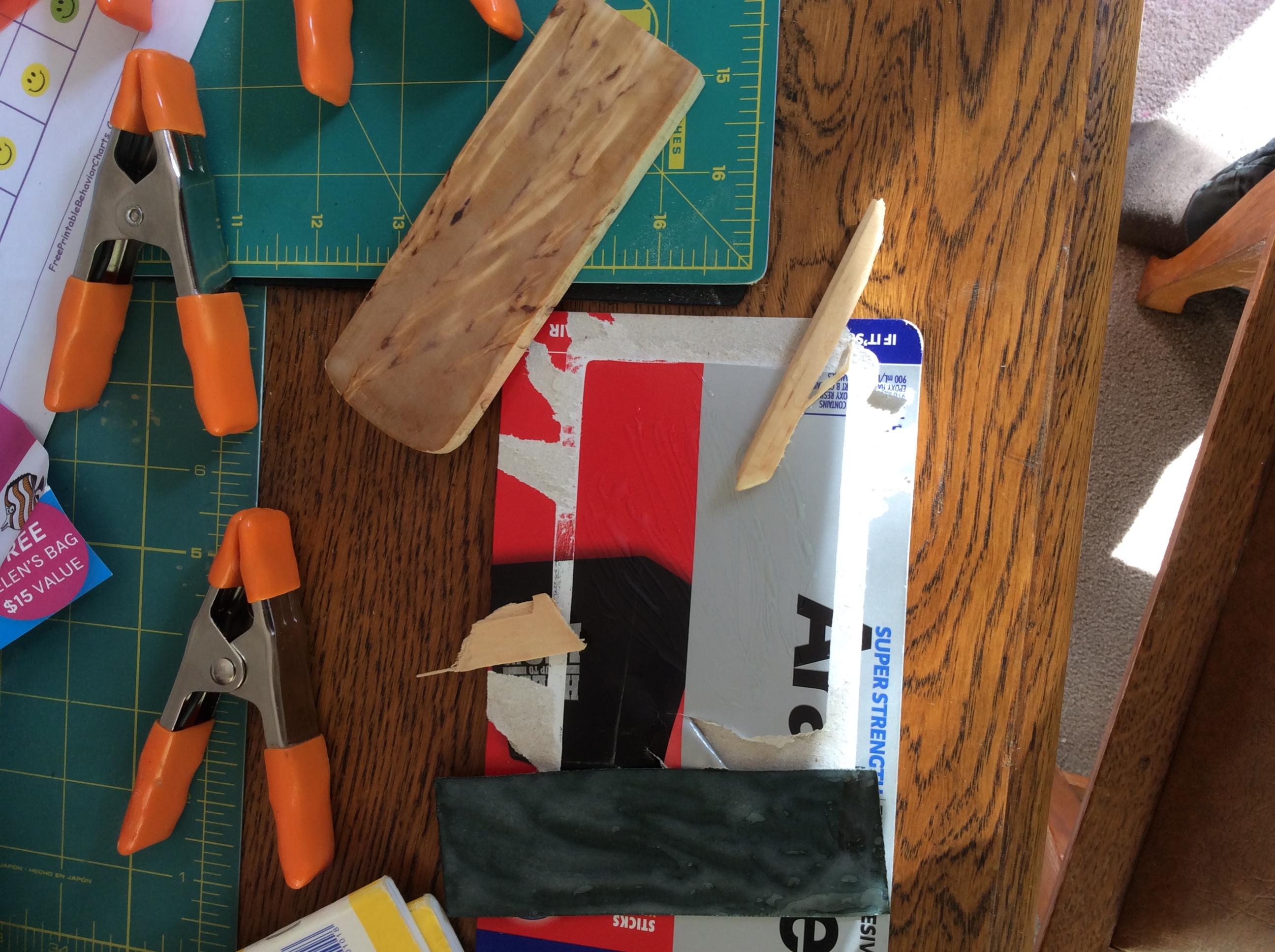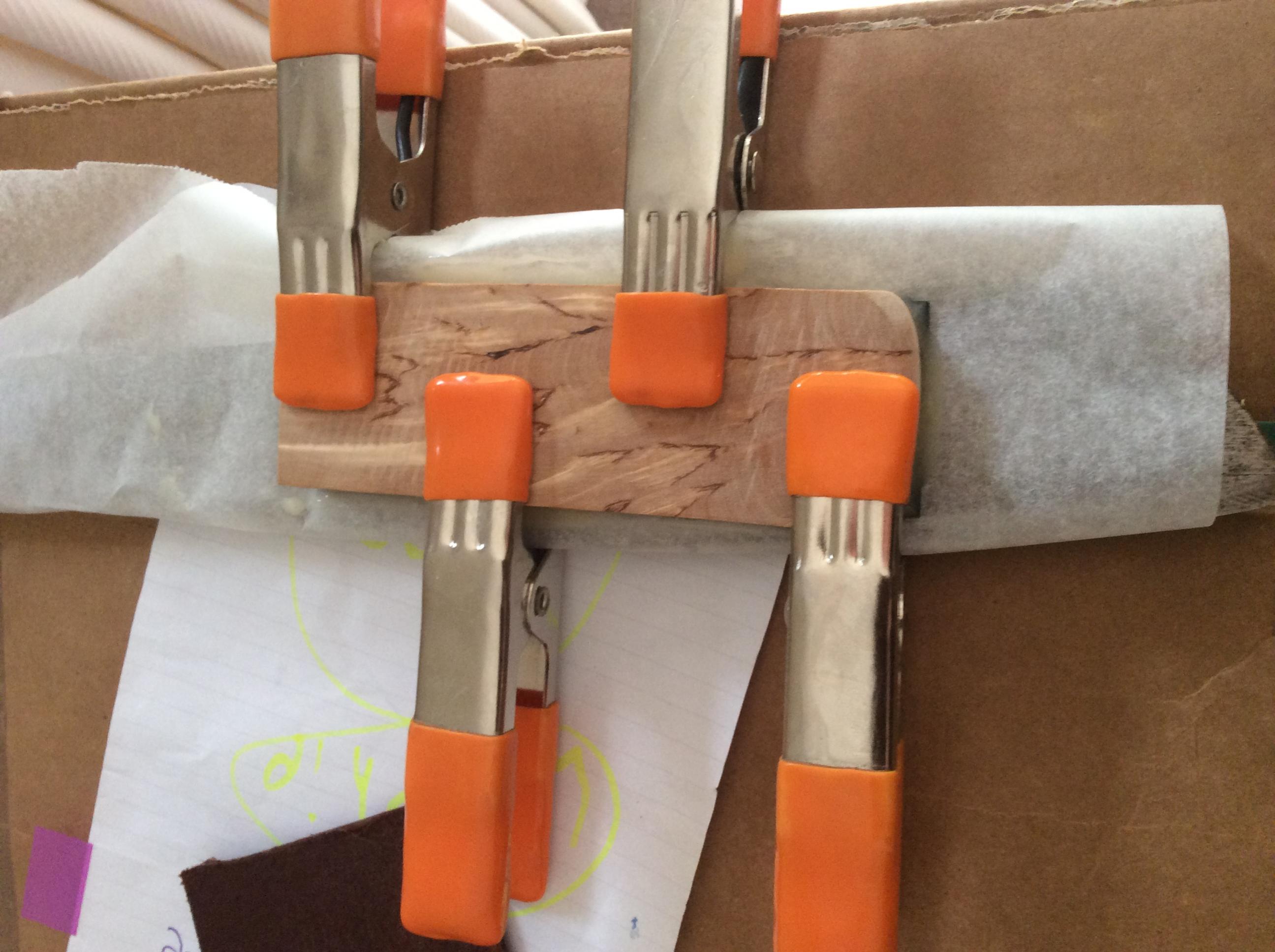So I have been lamenting the fact that I do not have a sanding machine, specifically a belt sander, after watching some you-tube vids they look pretty sweet, instead I have a pice of cork block and some sandpaper, ah well, noting wrong with a bit of sweat anyway!
Essentially I am trying to make the back or inside of my scales flat (not smooth but), so that the liners will adhere to them and so that the scales will sit on the tang properly, I want to keep the scales rough though as this increases the surface area for the epoxy to bond the liners to.
So that brings us to what the liners are and what they are for - these are Vulcanised Rubber Liners to be exact, they are .8 mm thick and I have gone for green ones. They are the sap from the rubber tree, mixed with a touch of dye and cured by adding sulphur (vulcanised), then rolled out into thin sheets and sold, there may be more steps in the process but I am not a chemical engineer, so thats what you get.
The purpose of the liner, and the actual facts are slightly different:
the idea is that if you have a carbon blade and wooden scales then the blade wood can absorb moisture and pass that onto the tang of the knife and it will rust, so you put an inert and impregnable material between the two and that should stop the process, simple really.
Unfortunately vulcanised rubber is not fully inert nor impregnable and it will absorb water when wet and lose it when dry and so not really do whats expected of it, its also a bit of a bitch to glue, as the glue has a hard time bonding to it. So saying it does have some of the sought after properties, just not all of them, a G10 liner would be much better, but I could not find one easily.
So why use it at all then? Well it does two things, the first is that it hides imperfections in your sanding process, the second thing is, to paraphrase Bob Loveless who said even a pretty girl looks better with lipstick is that it makes the knife look nicer, I am hoping to get a nice silver tang, green liners and a golden/orange coloured wood at the end of the day...well dreams are free, I am not holding my breath.
So I sanded, cleaned up the wood and liners with acetone to get rid of oils from my hands,mixed up some two pot epoxy, carefully applied that to both the liners and the handles, then clamped them together onto the blade of my golok with same baking paper in between to stop the glue sticking to the golok, then left them somewhere warm and dry for 24 hours, worked well, here are a couple of photos:
Next up will be drilling some holes
Shelley
Welcome guest, is this your first visit? Create Account now to join.
Welcome to the NZ Hunting and Shooting Forums.
Search Forums
User Tag List
+ Reply to Thread
Results 1 to 6 of 6
-
03-07-2015, 11:02 AM #1Member

- Join Date
- Aug 2014
- Location
- Auckland
- Posts
- 719
making a knife and a sheath, part 2 - liners
-
-
03-07-2015, 11:18 AM #2
Always wondered what the liners where for....cheers
While I might not be as good as I once was, Im as good once as I ever was!
Rule 4: Identify your target beyond all doubt
-
03-07-2015, 11:45 AM #3Member

- Join Date
- Jun 2015
- Location
- Auckland
- Posts
- 18
Great job Shelley.
I've got some red and black G10 or maybe it was micarta liner material. If you want two pieces send me a PM.
My experience with liners are that I drill them full of holes anyway to ensure the epoxy gets n directly from the blade to the wood. If you use good epoxy then it should provide some protection from water.
If you don't put holes in the liner, then you effectively have four glue joints that can fail instead of just two. I assume that you will put pins in too and they give the real strength.
Keep up the good work. It is great to get more people into knife making
Henny
Thipa. co.nz
Sent from my B1-730HD using Tapatalk
-
03-07-2015, 12:13 PM #4Member

- Join Date
- Jun 2012
- Location
- lower hutt
- Posts
- 1,049
ever thought of colouring the epoxy and then putting a washer or two in between the wood and tang to give you some space for the epoxy to show the colour? no problems with the rubber or whatever then
#BallisticFists
-
03-07-2015, 04:23 PM #5Member

- Join Date
- Aug 2014
- Location
- Auckland
- Posts
- 719
Nope never thought of that scoped, interesting idea though.
Thipa, thanks for the offer, if I stuff this up I may take you up on that offer!
-
10-07-2015, 12:38 AM #6Ejected

- Join Date
- Dec 2011
- Posts
- 2,572
I just used to use ol faithful. F2. Worked a treat and that was without cross bolts.
Similar Threads
-
Making a knife
By mellowski in forum HuntingReplies: 30Last Post: 07-01-2022, 04:35 PM -
making a knife and a sheath - part 1 (assembly)
By Shelley in forum Gear and EquipmentReplies: 4Last Post: 05-07-2015, 01:33 PM -
New Pocket knife , new sheath
By Ground Control in forum Projects and Home BuildsReplies: 11Last Post: 06-01-2014, 01:29 PM -
Folder knife sheath I made today
By Ground Control in forum Projects and Home BuildsReplies: 14Last Post: 17-12-2013, 07:10 AM
Tags for this Thread
Welcome to NZ Hunting and Shooting Forums! We see you're new here, or arn't logged in. Create an account, and Login for full access including our FREE BUY and SELL section Register NOW!!





 3Likes
3Likes
 LinkBack URL
LinkBack URL About LinkBacks
About LinkBacks





 Reply With Quote
Reply With Quote


Bookmarks